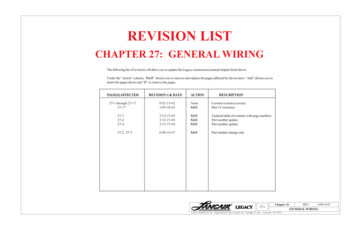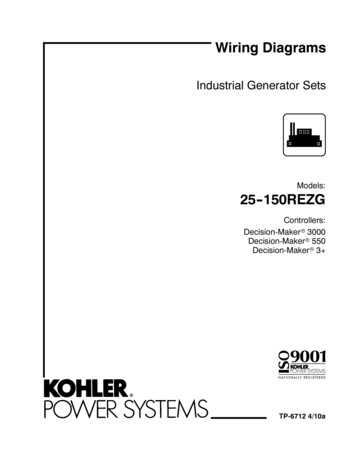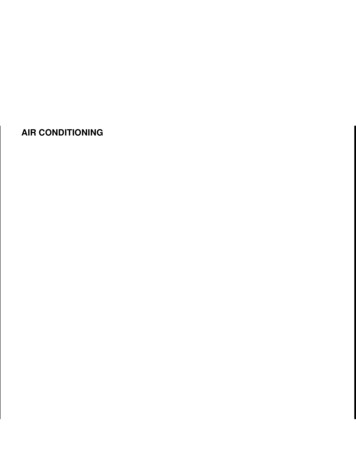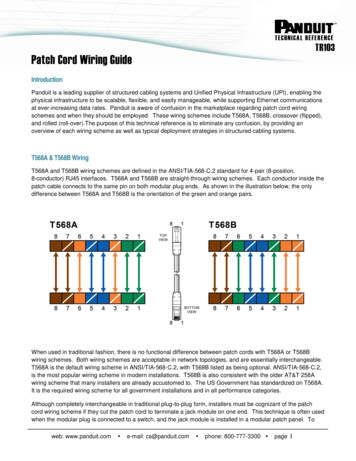
Transcription
REVISION LISTCHAPTER 27: GENERAL WIRINGThe following list of revisions will allow you to update the Legacy construction manual chapter listed above.Under the “Action” column, “R&R” directs you to remove and replace the pages affected by the revision. “Add” directs you toinsert the pages shows and “R” to remove the pages.PAGE(S) AFFECTED27-1 through 27-1727-17REVISION # & rrent revision is correctPart # 04R&RR&RR&RUpdated table of contents with page numbers.Part number update.Part number update.27-2, 27-56/08-10-07R&RPart number change only27-i18-iChapter2618ChapterLancair International Inc., Represented by Neico Aviation Inc., Copyright 2000 , Redmond, OR 97756REV.6/08-10-07GENERAL WIRING
Chapter 27: General Wiringtor, starter and master solenoid, mag switch, and the primary and avionics power sources(buses).ContentsWiring can be one of the most intimidating of all the different skills you learn whenconstructing a homebuilt aircraft. What makes matters even worse is that when you askthree different wiring “experts” about the best way to wire an alternator system, you willmost likely receive three different answers. If you plan on wiring your own Lancair Legacy, start reading! Tony Bingelis is the guru of homebuilding “how to”. His SportplaneBuilder column in Sport Aviation Magazine, and his books are a wealth of information onall aspects of homebuilding, including wiring. If you have kept your back issues of SportAviation, Mr. Bingelis’ column in the April, May, and June 1990 issues are excellent forgaining a good understanding of electrical systems.1. INTRODUCTION . 27-12. PARTS LIST . 27-23. CONSTRUCTION PROCEDURES . 27-3A.Basic Wiring Techniques . 27-3B.Legacy General Wiring . 27-4C.Basic Aircraft Wiring . 27-6D.Landing Gear Wiring . 27-7E.Lights Wiring . 27-8F.Electric Fuel Pump . 27-10G.Trim System Wiring . 27-11H.Flap Wiring . 27-13Setting the Flap Limit Stops . 27-151.I.Pitot Tube Heat Wiring . 27-16J.Electric Door Seal Wiring . 27-16K.Antenna Placement . 27-17INTRODUCTIONThis chapter will deal with the wiring necessary to get your Lancair Legacy functional.We will show you how to get power to the engine starter, then after the engine is fired up, howto get power from the alternator into the cockpit. From this point various systems, such aslights, trim systems, hydraulic system, fuel pump, etc., will be shown in wiring diagrams fromthe cockpit.We can’t show you how to wire all the different types of radios, GPS’s, VOR’s, HSI’s,NDB’s, and all those other various systems that can fill up a panel so expensively. These itemsmust be wired by the builder or a local radio shop using their own expertise. The basic goal ofthis chapter is to acquaint you with important parts of the electrical system, such as the alterna-Robert Nuckolls is also an excellent reference for wiring. He publishes a newsletter,The AeroElectric Connection, and also contracts his services to individual builders to design custom electrical schematics. He can be reached at:Medicine River Press6936 Bainbridge RoadWichita, Kansas 67226-1008(316) 685-8617Another popular option is to have a local electrical pro do your electric system foryou. This is generally a good idea at least for the radio stack wiring, but for the basic electrical system in your Lancair Legacy, you might be surprised how simple it is to wire.This chapter is a general wiring chapter. The diagrams are generalized for typicalLancair legacy installations. Equipment types and locations will vary from aircraft to aircraft. This chapter serves as a start to base your customized schematics on.Since this is a composite airframe, you don’t have the luxury of grounding to a convenient aluminum surface. You must bring a few ground posts into the cockpit, then terminate all your circuits to one of these posts. Although only one cockpit ground post isshown in the following schematic, it is a good idea to have several, even a couple in the gearbox area for the systems behind the wings. Ahead of the firewall, circuits are usuallygrounded to one of the engine bolts, which is in turn grounded to the battery.It seems that more and more breakers are being incorporated into the modern electrical system. You’ll notice in most of the wiring diagrams, a breaker symbol is shown adjacent to the master bus bar. The number in the symbol is the breaker size.Install circuit breaker sizes according to manufacturer’s recommendations.27-13/12-15-040/02-15-02GENERAL WIRINGChapter 27Lancair International Inc., Represented by Neico Aviation Inc., Copyright 2000 , Redmond, OR 97756REV.
2.PARTS LIST#PART NO. (P/N)QTYDESCRIPTIONOPTIONAL ITEM(not included with kit)#PART NO. (P/N)QTYDESCRIPTIONOPTIONAL ITEM(not included with kit)BASIC WIRING TECHNIQUESLEGACY GENERAL 000 5321K147)K1000-38)PH-250 (1” x 3” x 114411821884BASIC AIRCRAFT WIRINGBattery Box MountBattery BoxBolt, UndrilledBolt, UndrilledHoseHose ClampNutplatePhenolic Block ,1” x 3” x 3/8”Power gridRivetsWasher, *Yes**Yes**Yes**Yes**Contact Lancair AvionicsFLAP WIRINGContact Lancair AvionicsPITOT TUBEANTENNA PLACEMENTContact Lanair AvionicsContact Lancair AvionicsLANDING GEAR WIRING1)7101Airspeed Safety SwitchYes**LIGHTS WIRING1)4926 (Left)2)4927 (Right)3)01444)14-1005)A600 PR6)A600 PR7)14-1008)A-413, HDA, CF9)14-100111111111Taxi Light, Landing Light KitTaxi Light, Landing Light KitDimming RheostatInstrument Light SwitchLeft, Nav/Strobe Lights (Whelen)Right, Nav/Strobe Lights (Whelen)Nav Light Rocker SwitchPower Pack (Whelen)Strobe Light Rocker *ELECTRIC FUEL PUMP WIRINGTRIM SYSTEM WIRINGContact Lancair AvionicsNote:Optional Parts available through :(*)Lancair Avionics(**) Kit Components, Inc.27-26/08-10-070/02-15-02GENERAL WIRINGChapter 27Lancair International Inc., Represented by Neico Aviation Inc., Copyright 2000 , Redmond, OR 97756REV.
3.CONSTRUCTION PROCEDURESA.Basic Wiring TechniquesWire Size, Continuous FlowFig 27:A:1The wiring diagrams of this chapter donot include wire sizes. Wire sizes are determined from the wire size diagram.The wire size depends on load, lengthand voltage. As an example:1)14 feet installation2)28V source3)20 ampere drawFind the wire size.Answer:Find the number 14 under 28 voltssource column. Follow the horizontal line tothe right until intersects the slant 20-ampereline. At this point drop to the bottom of thechart. The value falls between No. 16 andNo. 14, select the larger size, No. 14.The wire will be placed in conduit, socurve 1 applies. The maximum continuouscurrent for No. 14 wire is 17 amperes.015020030040CURVE 1CURVE 2Note: Use aircraft quality wire. In choosing theproper wire consider requirements, operatingtemperatures, and environmental conditions27-3Chapter 27Lancair International Inc., Represented by Neico Aviation Inc., Copyright 2000 , Redmond, OR 97756REV.0/02-15-02GENERAL WIRING
Battery Box InstallationFig 27:B:1The battery box installs aft of the baggage bulkhead on the right side of the push-pull tube. You have beensupplied with a premolded battery box mount that bonds to the fuselage side.B.Legacy General Wiring1.Mount the battery box to the battery box mount before bonding the mount in place. The battery box shouldmount as high as possible and be centered on the mount.2.Install the power grid to the battery box mount.3.Bond the battery box mount in place. We suggest pre-aligning the mount and using clecos to realign and holdin place during bonding. The flat face where the battery mounts should be vertical.Power grid P/N 737-L2K-14. Available throughLancair Avionics.Secure the power grid with :Bolts AN3-10A, 4 places, Washers AN960-10, 4places, Nutplates K1000-3 and Rivets MSC-32, 4places.Trim the flange in front.1” x 3” x 3/8” phenolic spacer blocks.(These blocks are required to raise the power gridhigh enough to clear the nutplates.)The battery box mount, P/N 4038, bondsto the baggage bulkhead and the fuselage side.Produce a lightening hole. Also serves asan access hole should it be required.Bolt, AN3-5A (4 places)Washer, AN960-10 (4 places)Nutplate, K1000-3 (4 places)Rivet, MSC-32 (4 places)Battery box, available through Kit Components.27-43/12-15-040/02-15-02GENERAL WIRINGChapter 27Lancair International Inc., Represented by Neico Aviation Inc., Copyright 2000 , Redmond, OR 97756REV.
Battery Box InstallationFig 27:B:2VIEW LOOKING FORWARDFor dual battery box systems contact Lancair Avionics.BATTERY DRAIN DETAILHydraulicPumpPowerGridHose, 193-4Gear Down Switch, PS550, (Ref.)Low Pressure SideSmall Hose Clamp145-0000 5321K14Idler ArmBattery BoxMountGear up Switch,PS 1000 (Ref.)Put the 1/4”aluminum tube in withepoxy/flox.BatteryBoxHigh Pressure SideReturn Line27-56/08-10-070/02-15-02GENERAL WIRINGChapter 27Lancair International Inc., Represented by Neico Aviation Inc., Copyright 2000 , Redmond, OR 97756REV.
Basic Aircraft WiringBasic Aircraft Wiring DiagramFig 27:C:1This diagram shows a very basic aircraft system. All other systemswould branch off this system.F1F2This is an unshielded, heavy gage wire.AlternatorNo shielded wire needed.BEngineVoltage Regulator(See Mfg. schematic for specific wiring)StarterNoise suppressor,Aircraft Spruce,11-08060L.MagAStarterRelayR.MagFuses5 AmpMasterRelayShuntC.Fuses50 dwireRef.: FirewallCockpitgroundpost AvionicsMasterAmmeterPrimary (Master) busAvionics busBRLSIgnitionswitchMasterswitch27-6Chapter 27Lancair International Inc., Represented by Neico Aviation Inc., Copyright 2000 , Redmond, OR 97756REV.0/02-15-02GENERAL WIRING
D.Landing Gear Wiring DiagramFig 27:D:1Landing Gear WiringThe landing gear wiring consists of three main systems, hydraulic pump, gear indicator light, and an airspeedsafety switch. The hydraulic pump is controlled through pressure switches that activate the solenoids. The gear upsolenoid should be protected by an airspeed safety switch. This switch basically leaves the circuit open until theaircraft reaches a pre set speed. This is to prevent accidental gear retraction on the ground. The switch has anadjustment feature for setting the speed. We suggest you set the speed between 80 to 90 KIAS. The switch isavailable through KCI.Green Gear Lights# 22MicroSwitchGear LeftTo (*) BussBar# 22DIODES FOR TRANSITIONLIGHT. USE ANY COMMON 1/4WATT RECTIFIER DIODE.Gear NoseAn important part of the gear system is the gear indicator lights. The gear indicator light switches are installedon the over center links. This very simple circuit basically closes when the over center link is locked in the downposition.# 22Gear Right2There is also a light to indicate the pump is running. This light is typically amber in color and indicates wheneither the up or down circuit is activated.To (*) BussBarMount the indicator lights as high as possible on the panel to take advantage of the shade provided by theglare shield. As with any light it is hard to see if it is lit if the sun is shining on it. The lights are usually mounted in atriangular pattern, with the nose gear indicator above the two mains.The landing gear indicator lights work through the micro switches you have already installed on the main gearand nose gear. This circuit is as simple as it gets. When the micro switch at each gear location is grounded out, theindicator light on the instrument panel illuminates.# 22Low Pressure Switch# 22High Pressure SwitchNext to the gear position indicators, mount the hydraulic pump indicator, which is amber in color. This lightwill now illuminate when the hydraulic pump is running, like when the gear is cycling, or when hydraulic systempressure falls off.PITOT INPUT -GearDownRelayGreen# 10BlueBlackHyd.PowerPack# 22Airspeed SafetySwitch710REDCADJUSTMENT1 9 GearUpRelay# 10GearSwitchNCGearAirspeedSwitchP/N 710NOSTATIC INPUT# 22TRANSITIONLIGHT35A# 10#4BLUEMasterRelayBattery# 222AmpBreakerTypical Mounting* Buss Bar*Size to load requirements(approx. #5)RED - CommonBLUE WIRE- NormallyopenWHITE WIRE - Notnormally used27-7Chapter 27Lancair International Inc., Represented by Neico Aviation Inc., Copyright 2000 , Redmond, OR 97756REV.0/02-15-02GENERAL WIRING
E.Position/Strobe Light SchematicFig 27:E:1Lights WiringExterior lighting on the Lancair Legacy consists of wingtip position/strobe light, a landing light, and a taxi light.There are variations, of course, but this section will stick to the basics.Master bus10Inside the cockpit, instrument lights, or post lights, illuminate the panel for night flying. A cabin light is alsosometimes installed. A schematic is given for the simple instrument wiring, but not for the cabin light.The following schematic shows the wiring of the position/strobe lights. A more complete explanation of thissystem is provided in the installation kit commonly purchased along with the lights and power pack. Basically thereare two wires coming out of each light unit for the red/green/white position lights. The other three wires out of eachunit are used for the strobes.NOTE:7½Nav lightrocker switchACS part # 14-100Strobe lightrocker switchACS part # 14-100Also refer to the installation andservice manual supplied by Whelen.Nav/positionlight greenNav/positionlight redStrobeStrobe1WhelenA600 PRRight, Nav/Strobe LightsNOTE:234WhelenA-413, HDA, CFPower PackWhelenA600 PGLeft, Nav/StrobeLightsUse shielded wire to strobe lights.27-8Chapter 27Lancair International Inc., Represented by Neico Aviation Inc., Copyright 2000 , Redmond, OR 97756REV.0/02-15-02GENERAL WIRING
Landing and Taxi LightsFig 27:E:2Instrument Light SchematicFig 27:E:3There are an increasing number of instrument lighting methods. The old standby, postlights mounted adjacent to every instrument are giving way to internally lit instruments and lighted instrument covers. Whichever methodyou choose, most likely they will be wired similarly to the schematic below.Taxi Light4926 (Left)Landing Light4926 (Left)MasterBusLanding Light4927 (Right)Taxi Light4927 (Right)MasterbusInstrument lightswitch(ACS Part #14-100)Dimming rheostat(ACS Part #0144)The optional landing and taxi light installations are installed in the stub wings. Youcan install a taxi light and landing light in the right wing, left wing or both wings. Refer tosection J of chapter 3 for the installation procedure. Beware that the circuit breaker sizedepends on whether you install one or two landing lights on one breaker.Instrumentlights(Post lights)27-9Chapter 27Lancair International Inc., Represented by Neico Aviation Inc., Copyright 2000 , Redmond, OR 97756REV.0/02-15-02GENERAL WIRING
F.Fuel Pump Wiring, Continental InstallationFig 27:F:2Electric Fuel PumpThe electric fuel pump mounts in front of the main spar in the center console. There are two different versionsof pumps installed depending, a single stage for the Lycoming installations and a dual stage for the Continental installations (refer to chapter 4, section G).Master BusThe Lycoming installations use a single stage pump (high boost). The boost pump is used for priming theengine, takeoff (not landing), and emergency.The Continental installations use a dual stage. Again the high boost is used for priming the engine and foremergency and the low boost can be used for vapor suppression.Fuel Pump Wiring, Lycoming InstallationFig 27:F:1AAHigh black)P/N for 12VPump5456-00-1 (Ref.)Elec.boostpump(Dukes)P/N for 12VPump5455-00-1 (Ref.)BA- Primer switch , SPDT, MOM On, Push buttonA- Primer switch , SPDT, MOM On, Push buttonB- Boost pump rocker switch, SPDT, Center Off, Hi/Off/LowB- Boost pump rocker switch, SPDT, Center Off, Hi/Off/LowNOTE: The pump is not polarity sensitive so either ofthe two lines can go to ground.27-10Chapter 27Lancair International Inc., Represented by Neico Aviation Inc., Copyright 2000 , Redmond, OR 97756REV.0/02-15-02GENERAL WIRING
G.Trim System WiringWiring instructions are included with your trim systems. The following diagrams suggest wire routing and pluglocations. You should be able to remove one servo alone or a control surface by unplugging the servo. For wiringthe T2-10A (elevator trim servo) refer to the wiring diagram that comes with the servo kit.Elevator trim servo wiring: We suggest running the wires through the elevator spar and inboard through theelevator access panel. Then through the vertical sternpost and down to the bottom of the sternpost and forwardthrough the aircraft.Elevator and Rudder Trim SystemsFig 27:G:1Install a grommet inthe leading edge of the rudderRudder5 Pin Connector availablefrom the Ray Allen company.Elevator TrimServoS6A (T2-10A) Ref.5 Pin Connector availablefrom the Ray Allen company.Rudder Trim ServoT2-7A (S4), Ref.Rudder trim servo: We suggest running thewires through the rudder spar and throughthe rudder leading edge. Run the wiresstraight down to the base of the sternpostand then forward.ElevatorSecure the wires as required. Be sure toallow for control surface movement.VerticalSternpost27-11Chapter 27Lancair International Inc., Represented by Neico Aviation Inc., Copyright 2000 , Redmond, OR 97756REV.0/02-15-02GENERAL WIRING
Aileron Trim Servo WiringFig 27:G:2Both wires out of the aileron servo are white. For now you can wire the servo without identifying which iswhich. When the system is completely wired, check that the trim tab moves the servo the correct direction. If itdoesn’t switch the wires at one of the plugs.Run the wires through the dry bay andinto the “T” fitting of the main spar.Run the wires along the base of the mainspar and through the center console.Outboard Wing Section Main SparCenter Wing Section Main SparDrill a holethrough the aftspar for theservo wires.Aft SparStrobe/NAV Lights - Runwires through leading edgeconduit.2 Pin ConnectorAileron TrimServoT4-5-T5NAV Antenna - Run wiresthrough the leading edge.NOTE:By running the servo wires close to the hinge line,the wires will not have to bend so much when theaileron is deflected, saving wear and tear.27-12Chapter 27Lancair International Inc., Represented by Neico Aviation Inc., Copyright 2000 , Redmond, OR 97756REV.0/02-15-02GENERAL WIRING
H.The relays can be secured to the motor or elsewhere.Flap WiringThe Lancair Legacy flaps are driven by the 12V electric linear actuator. Also the limit stops are set by thecustom limit stop (micro switch) assembly that mounts directly over the actuator shaft. It is operated by magneticreed switches.H 1.NOTE: There are 4 wires that will travel forward to the instrument panel:1.Ground2.Up limit switch3.Down limit switch4.Positive ( ) to the relays.There are two DPST (double pole, single throw) relays required to connect them. The part number for the12V system is LY1 and for 24V it is LY1-24V. Also a DPDT Momentary On switch is needed to operate the flaps(Part # MS24658-23D).See Figure 27:H:1 for the flap wiring. If you have trouble interpreting the schematic, don’t worry, the additional drawings will take you through this installation in a simple pictorial manner.H 2.Secure the wires so that they can not possibly get tangled up with any of the flap actuator movements.H 3.Before wiring the relay / flap motor assembly it is important to first establish the proper polarity of the motor.Or put another way, you must determine which wire on the motor is ( ) when the actuator is extending. Byplacing one of the motor leads on ( ) and one on (-) on any handy 12V battery, locate the correct combination that extends the actuator shaft. Mark that appropriate wire ( ) for future reference. This extensionmovement will act to bring the flaps UP.H 4.Attach the limit switch assembly to the actuator shaft. (The final position will be determined later, but fornow, just put the magnetic reed switches on opposite ends of the base bracket - not all the way to the endsthough.) The limit switch that is at the far end of the shaft (away from the motor) is the one that will limit theflaps UP position.H 5.For the sake of discussion, let’s pick relay #2 as the one to be used for flaps UP. The other relay will beused for flaps DOWN. With this established, the wire marked “Limit Switch #2 is connected to that limitswitch. See figure 27:H:2. Also, the wire on relay #2 marked “to motor” must be connected to the flapmotor wire which was earlier labeled ( ). Now we have the motor turning in the correct direction for flapsUP and the motor will be stopped by the correct magnetic reed switch (or limit switch).H 6.The flap control switch has two possible wires that could connect to the above limit switch #2. See drawingof a typical control switch in figure 27:H:4. Either wire can be used on limit switch #2, this will howeverdetermine which way the flap control switch moves to extend the flaps. Naturally, you want the movementon the control switch to be either “downward” or “aft” when dropping flaps. If the direction ends up beingopposite, just turn the switch around in its instrument panel mounting hole.Flap Motor Wiring SchematicFig 27:H:1To BusBar1010 amp fuseorcircuitbreakerDPDTswitchNC LimitswitchNC LimitswitchRelayDPSTRelayDPSTPer figure 27:H:2, connect the wiring to these relays and attach the wires to their respective locations. The“spade” connectors on the relays are .187” in width. Use #18 wire.FlapmotorNCNC27-13Chapter 27Lancair International Inc., Represented by Neico Aviation Inc., Copyright 2000 , Redmond, OR 97756REV.0/02-15-02GENERAL WIRING
Flap RelaysFig 27:H:2To GROUND (-)Flap Reed SwitchFig 27:H:3To CONTROL SWITCH and ( )THROUGH CIRCUIT BREAKERAdjust motor travel by sliding switch along channel, lockdown with set screw into lower tab in channel groove.To MOTORMagnetic reed switch (one for opposite end is not shown).This tab not used (Normally Open).To #2 LIMIT SWITCH (-)To DPST relayTo flap control switchTo #1 LIMIT SWITCH ( )Second reed switch mountssimilarly at this end.To MOTORAPFL Y #2LAREAPFL Y #1.187” spade connectors typ.LAREH 7.H 8.Flap relayschematic12345678This end of rod ismagnetized and will tripthe switch - thus stoppingthe motor.Slide over motor actuator shaftand lock down with set screws.The magnetic reed switch will have three possible contact points. Use the center contact and ONLY thecontact labelled “W”.SetscrewNOTE: When setting the wiring for the limit stops, calculate extra wire so that you will be able to fit thecustom dust cover over this limit switch installation and be able to route all the wires through its exit holewhich is on the END.ReedswitchAfter completing all the wiring, test run the system and check for two things:a. The limit switches must stop the travel in their respective directions;b. The motor must be self braking. That is, when you release the control switch, the motor should stopquickly instead of gliding or coasting for two or three seconds. Such coasting is not acceptable and willnot occur if everything is wired correctly.This end bolts to theshaft end of flap motor.Lower lockingtab27-14Chapter 27Lancair International Inc., Represented by Neico Aviation Inc., Copyright 2000 , Redmond, OR 97756REV.0/02-15-02GENERAL WIRING
Flap Wiring DiagramFig 27:H:4Setting the Flap Limit Stops1.When adjusting the DOWN limit stop, run the flaps to the proper down limit position (40 degrees). Simply“zero” the smart level in the “up” position. As the flap travels it will read the actual flap setting.2.When it is all adjusted properly, check that the limit stop screws are snug and check that the hex nut thatsecures the clevis onto the flap motor is also tight against the clevis.LIMIT SWITCHFLAPS DOWNFLAP MOTORWITH LIMIT SWITCH ASSEMBLYTYPICAL FLAP CONTROL SWITCHmust be DPDT, momentary ON switchWARNING:3.If the flap clevis check nut is not tight, it could allow the actuator shaft to turn inthe clevis. This could eventually thread the actuator out of the clevis and cause atotal flap failure. Be sure to set this check nut.The limit stop assembly is provided with a dust cover that can be wire tied over this installation. A couple ofdabs of silicone will also help secure it in position.250 SPADE CONNECTORSTYP.#18 WIRE TYP.To GROUND BUSTO POSITIVE BUS through a10 amp fuse or circuit breaker.( ) POSITIVE TO MOTOR(Note: Establish the proper order of wires from motor.This wire must be ( ) and motor must run so as to extend the actuator shaft instead of retracting it.)layRe 2#layRe 1#RELAYS.187 SPADE CONNECTORSTYP.27-15Chapter 27Lancair International Inc., Represented by Neico Aviation Inc., Copyright 2000 , Redmond, OR 97756REV.0/02-15-02GENERAL WIRING
Pitot Tube Heat WiringJ.Electric Door Seal WiringPitot Tube Heat WiringFig 27:I:1Electric Door Seal WiringFig 27:J:1The inflatable cockpit seal is kept at 20 psi by a remotely mounted air pump. In this system, a pressureswitch activates the pump when the seal pressure falls below 20 psi. When the pump is turned off, the pressure inthe door seal will vent out through the panel mounted on/off switch. Refer to Chapter 9 for seal installation.Inflatable Cockpit Seal4940-01Pitot Heat SwitchMaster Bus(When pressurereaches 20 psi, pump isshut down until pressurefalls again, etc, etc.)SealVent20 psi Pressure Switch0155406041032To GroundAir LinesPumpCheck valve preventspressure from bleedingoff through the pump.Pneumatic Door seal switch on instrumentpanel in the “ON” position. Pressure isconnected to the door seal.(MJTV-3)(4LO-051-000)SealPitotTubePull type circuitbreaker or installa switch in thepower line.Circuit Breaker 10AMasterBusRecommended MinimumWire Size AWG 16VentI.PumpDoor seal switch is shown here inthe “OFF” position. Pressure lineis blocked off and the door seal isvented to the cockpit.Electric Door SealPump326-0-12 or 326-0-2427-16Chapter 27Lancair International Inc., Represented by Neico Aviation Inc., Copyright 2000 , Redmond, OR 97756REV.0/02-15-02GENERAL WIRING
K.Antenna PlacementIn the constantly changing world of avionics, what you read in this section may be outdated in a year. Asan example Loran was the hot thing just a few years ago. With the GPS the Loran system is now obsolete. Thissection outlines recommended placement and location.Antenna PlacementFig 27:K:1GPS. Recommended placement is under the dust cover. It must be far enough aft so the antenna can“see” through the window. Remember: The GPS signals will not penetrate carbon. The antenna itself isnormally supplied with the GPS.2.Marker Beacon. Recommended placement is in the joggle provided in front of the spar. Also seesection 3-B. The antenna part number is CL-102.3.Transponder Antenna. Recommended placement is just aft of the main spar in line with the com andmarker beacon antennas. Later kits have a premolded joggle for the transponder antenna. Refer tosection 24-D.4.Com Antenna. Recommended placement is in the joggle provided just aft of the aft spar. See section 3C. the antenna part number is CL122C. If you’re installing 2 com radios you can use a splitter or install2 antennas.5.TCAD Antenna. Call Lancair Avionics.6.Stormscope Antenna. See chapter 25-5. Also call Lancair Avionics.7.Nav Antenna. The NAV antenna may be in either the left or right wing tip. The antennas are preinstalled at the factory.8.ELT (not shown). Refer to section L WIRINGChapter 27Lancair International Inc., Represented by Neico Aviation Inc., Copyright 2000 , Redmond, OR 97756REV.
The landing gear wiring consists of three main systems, hydraulic pump, gear indicator light, and an airspeed safety switch. The hydraulic pump is controlled through pressure switches that activate the solenoids. The gear up solenoid should be protected by an airspeed safety switch. This switch basically leaves the circuit open until the










